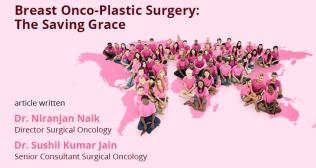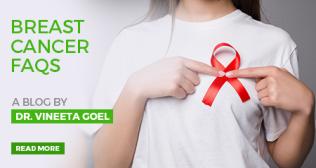
Best Breast Cancer Treatment in Mumbai
Best Breast Cancer Treatment in Mumbai
Getting to know that you or a loved one has breast cancer can bring a whirlwind of emotions – fear, anxiety, anger, tearfulness, shock, uncertainty, and more. It’s a lot to take in, but what matters most is gathering information as much as possible, exploring all treatment options, and receiving expert care from the start, which will give you the best chance of a cure. As a leading cancer hospital in India, breast cancer patients seeking treatment at Fortis Hospital, Mulund, will receive expert, compassionate, and personalized care from a team of dedicated oncologists and surgeons, utilizing the latest technology and treatment innovations.
This article explains the different aspects of breast cancer, including how to recognize its signs and symptoms, causes and risk factors, treatment options, prognosis, and what you can do to prevent or lower your risk. It also highlights the approach to breast cancer care at Fortis Hospital, Mulund.
Why Choose Fortis Hospital, Mulund, for Breast Cancer?
Whether you’re newly diagnosed with breast cancer, or at high risk for the disease, our world-renowned breast cancer experts offer unwavering support throughout your health journey, from initial diagnosis to treatment and beyond.
You can count on us for:
- Advanced diagnosis and treatment – our doctors use the latest technology and techniques to accurately diagnose and treat all forms and stages of breast cancer. The expertise of our specialists combined with state-of-the-art imaging tools like 3D mammograms and MRI, enables early detection of breast cancer, when the disease is most treatable. Our experts also keep up on the latest advances and evidence-based therapies to incorporate into your treatment plan.
- Comprehensive, personalized care – our experts work with you and your family to create a treatment plan tailored to your specific condition, as well as your needs and goals.
- Multidisciplinary approach – our multidisciplinary team approach brings together specialists from diverse medical fields to ensure that patients receive the best treatment based on their specific needs, leading to improved outcomes.
- A full range of treatment options – patients have access to a full spectrum of effective treatment options, including surgery, chemotherapy, radiation therapy, hormonal therapy, targeted therapy, as well as supportive care.
What is Breast Cancer?
Breast cancer refers to a group of cancers that originate from the breast tissue. It occurs when cells in the breasts mutate and multiply uncontrollably. While breast cancer mostly affects women, particularly those aged 50 and older, men can also get it.
Breast cancer can be broadly classified as invasive (cancer cells have spread to nearby tissue or other parts of the body) and non-invasive (cancer cells have not spread from the original sites).
What are the Signs and Symptoms of Breast Cancer?
Breast cancer can develop silently, which means the disease may be present but cause no noticeable symptoms. That is why many women receive a breast cancer diagnosis during routine mammogram screenings. Yet, it’s important to know that mammograms, while a valuable screening tool, can sometimes miss a diagnosis of breast cancer. Knowing how your breasts normally ‘look and feel’ is crucial for early detection of any abnormalities that could signal breast cancer. Signs and symptoms of breast cancer, when they appear, may vary and include:
- A small lump or mass in your breast or armpit
- A change in the size, shape, or appearance of your breast
- Changes in the skin of your breast or nipple – such as redness, dryness, or thickening of the breast skin
- Breast skin that looks dimpled or appears like an orange peel, or may look scaly, inflamed, or darker than other parts
- Swelling of all or a part of your breast
- Nipple turning inward
- A bloody or clear fluid discharge from your nipple
- Noncyclic breast pain (does not relate to your menstrual cycle)
See a doctor if you see a lump or any changes in your breast, in addition to these symptoms.
What Causes Breast Cancer?
The exact cause of each breast cancer case isn’t known. Breast cancer occurs when normal breast cells turn into cancerous cells due to changes or mutations in genes. Some gene changes are inherited, meaning the mutations are passed from parents to children, while others are acquired (not inherited). These changes in the DNA instruct cancer cells to grow and multiply quickly, forming tumours, which can eventually spread to other parts of the body. This is called metastatic cancer.
Risk factors for breast cancer:
Risk factors that may increase a person’s chances of developing breast cancer include:
- A family history of breast cancer
- A personal history of breast conditions, including breast cancer
- Being female
- Dense breast tissue
- Advancing age – aged 50 and older
- Inherited gene changes – mutations in tumor suppressor genes like BRCA1 and BRCA2 increase the risk of breast cancer and ovarian cancer. These changes can be passed down from a parent to their child.
- Never having been pregnant
- Menstruating at an early age – before age 12
- Starting menopause at an older age – after age 55
- Using hormone replacement therapy (HRT) to control menopausal symptoms
- Radiation exposure
- Being obese
- Smoking
- Drinking alcoholic-beverages
What are the Types of Breast Cancer?
Doctors categorize breast cancer into different types based on which breast cells become cancerous, and whether it’s invasive or non-invasive.
Common types include:
- Invasive ductal carcinoma (IDC) – the most common type of breast cancer, accounting for about 70-80% of all breast cancer cases. Invasive ductal carcinoma arises from the ducts, the tubes that carry milk to the nipple, and can spread to nearby breast tissues or other parts of the body through the lymph nodes and bloodstream.
- Invasive lobular carcinoma (ILC) – the second most common type of breast cancer that starts in the milk-producing glands in the breast, called the lobules. It can invade the surrounding tissues of the breast and other parts of the body.
- Ductal carcinoma in situ or DCIS – this non-invasive breast cancer begins in the milk ducts and has not spread to the nearby breast tissue. The cancer cells are still confined to the ducts, however, these cells can progress to invasive, if left untreated.
Other types include –
- Inflammatory breast cancer (IBC) – a rare and aggressive type of breast cancer that causes the breast to become warm, red, and swollen.
- Triple-negative breast cancer (TNBC) – another rare and aggressive type of breast cancer that spreads more quickly than other types, making it difficult to treat.
- Paget’s disease of the breast – this rare type of breast cancer affects the skin and areola of the nipple.
How is Breast Cancer Diagnosed?
To diagnose breast cancer, your doctor may conduct a series of tests and procedures, including:
- Clinical breast exams - to check for lumps and other signs of breast cancer.
- Breast imaging tests such as mammograms, ultrasound, and MRI scan, to help detect cancer and other abnormalities in the breast.
- Breast biopsy – to confirm if cancer cells are present and to determine the type of breast cancer.
- Genetic tests – to look for genetic changes or mutations that can cause breast cancer.
- Immunohistochemistry test - to look for hormone receptors.
If breast cancer is confirmed, your doctor will likely order a few additional tests to determine the stage of cancer, which will help your doctor decide on the best course of treatment and understand the prognosis.
How is Breast Cancer Treated?
At Fortis Hospital, Mulund, our multidisciplinary team of experts will work with you to customise your treatment plan based on the specific type and stage of breast cancer you have. Your treatment plan will also depend on preferences and overall health.
Your oncologist may suggest one or more of the following treatment approaches:
- Surgery – different types of surgery, such as mastectomy, lumpectomy, and breast reconstruction, may be used to remove the breast cancer.
- Chemotherapy – to destroy cancer cells.
- Radiation therapy – to target and kill cancer cells.
- Hormone therapy – to block hormones (like estrogen and progesterone) that fuel cancer cells to grow. This therapy can cause cancer cells to shrink or die.
- Targeted therapy – to specifically target cancer cells.
- Immunotherapy – to identify and kill cancer cells using the body’s own immune system.
What’s the Outlook/Prognosis for Breast Cancer?
The outlook for breast cancer is different for everyone, depending on various factors like the type of breast cancer, whether it’s invasive or non-invasive, the rate of tumor growth, the person’s general health and fitness, etc. Survival rates among breast cancer patients are improving as advances in screening allow doctors to detect the disease earlier, significantly increasing the chances of successful treatment and a cure. Even when a cure is not achievable, many treatments can help extend life.
Can You Prevent Breast Cancer?
There’s no proven way to prevent breast cancer entirely, however, you can take healthier steps to lower your risk. These include:
- Eating a balanced diet, focusing on whole foods.
- Limiting alcohol intake.
- Staying physically active.
- Maintaining a healthy weight.
- Being familiar with your breasts through regular self-exams.
- Talking to your doctor about when to start breast cancer screening and what screening tests are right for you – for instance, mammograms can help detect early signs of breast cancer.
If you have a risk factor, be sure to discuss it with your doctor to explore other options for reducing your risk.
Takeaway
Breast cancer is a prevalent cancer, particularly among women. Many women with breast cancer may not have any noticeable symptoms in the early stages and the disease is detected during routine screenings. Recognizing any changes in your breasts, such as a lump or nipple change, and seeking medical help is important for early diagnosis and successful treatment. The good news is, advances in breast cancer screening and treatment modalities have led to significant improvements in overall survival and patient outcomes.
The breast cancer experts at Fortis Hospital, Mulund, provide personalized and innovative treatments to achieve optimal patient outcomes.
Categories
Clear allMeet the doctor

- Oncology | Medical Oncology
-
18 Years
-
2000



















